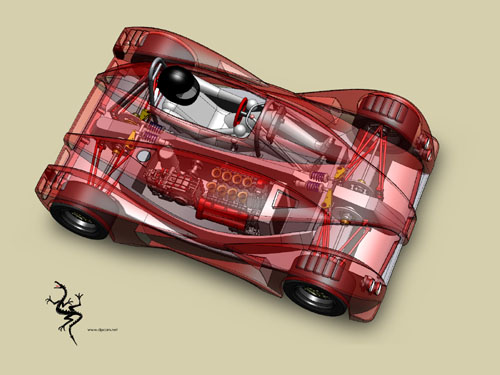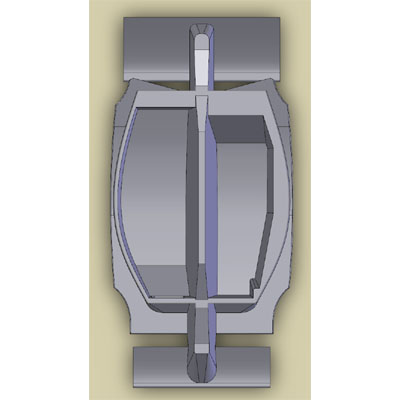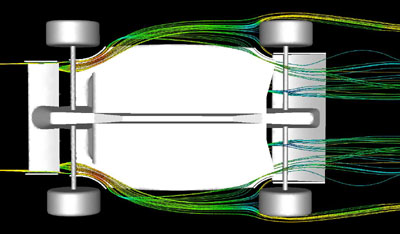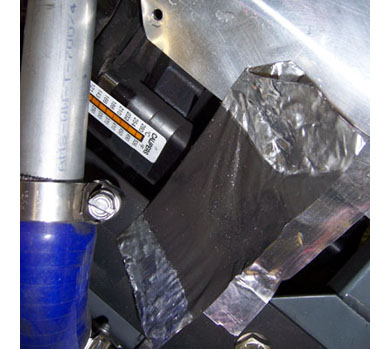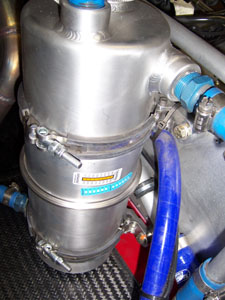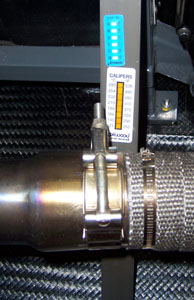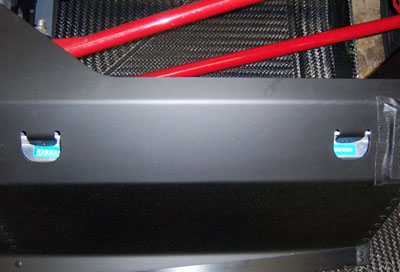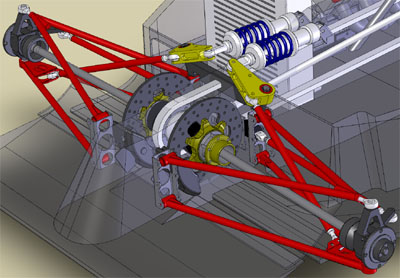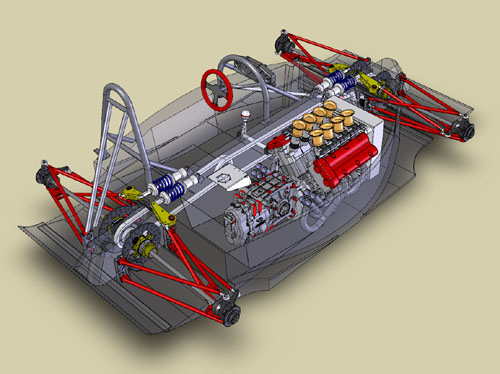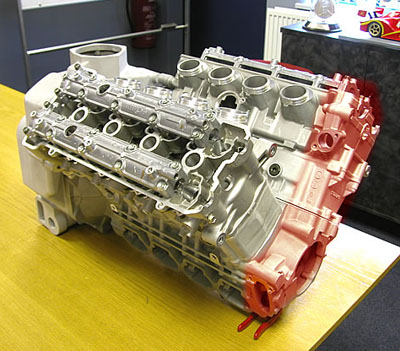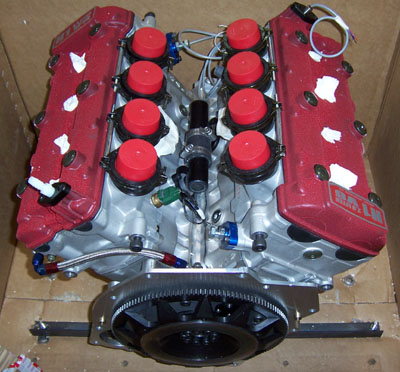|
12/29/06 Feeling a bit lazy in the last few days of 2006, so it's time to reflect back on the progress made (which is considerable) and contemplate the list of things still to be done (which is even more so). In that spirit I did a few cosmetic things. First, a new desktop background for myself (click the picture for a 1600x1200 image if you want it). Then, realizing that the new chassis essentially resembles a Greek letter 'Phi' I came up with an idea for a different dpcars logo that would tie into that.
Now that I look at it I think someone may have suggested something along these lines in the past... Well, now there's a good reason for it. Not totally set on it yet but kind of leaning towards it. Of course in either case the lizard remains as a 'mascot' and a secondary logo. 01/03/07 I've been having a lot of very educational discussions on aerodynamics with some real experts in the field, people directly involved in aero design at very high levels in racing including Indy both past and present. Their backgrounds vary and include leading-edge CFD and hands-on, make-the-car-work practical application. I'm very fortunate to have access to this kind of expertise and to be able to compare opinions and advice from people with different experience. Gratifyingly, so far they tend to agree on pretty much all the major issues, without ever having spoken to each other. It is an interesting process, with me coming up with ideas and the experts telling me why some might work and why others most likely won't. Quite a few in the latter category :) The most important thing is that a car is a very complex device aerodynamically, with extensive 3-dimensional flows, most of which are turbulent and in the proximity of the ground. Vortex generators, although frowned upon by some as 'bandaids', are a very important tuning tool in this context and are unfortunately still mostly a hands-on thing as their effects are extremely difficult to model but can be very significant. I was told of one instance of a 20% increase in downforce without an increase in drag by using VGs. This is why CFD requires extensive expertise and understanding of the issues involved to be really useful. That includes constructing the model appropriately, which I'm not at all certain that I'm doing right. But I aim to learn. Even with the best resources all the analytical tools are just guides, not an absolute. This is why top race teams keep spending millions every year on aerodynamics including CFD, wind tunnel testing and actual track tests. If it were possible to definitively solve the problem they'd likely have done it once years ago and put those millions into the beer budget instead to celebrate (well, OK, the ever-changing regulations play a big part but you get the idea). Bottom line is, as far as I can tell everyone is essentially still guessing - the key difference is just how educated the guesses are and how creative and thorough is the process. So one of the items on my agenda for my own development process is to see how well CFD correlates with actual experience, if possible finding out where the differences are and how to account for them so that in the future I can both get better results and make better use of the results I get. I'm not going to show in detail what I'm trying to do under the car, but here is a neat picture from above. Bodywork of course would change it a lot so this is just here for eye-candy factor :)
Naturally the model has evolved quite a bit since then so we'll see if the next generation is an improvement or not. The initial numbers indicate about 80 lb downforce at 80 mph, or about 10% of the car's weight. Theoretically this would translate to several hundred lbs at 160 mph but that's not the immediate goal. One of the big challenges I have is to try and produce some useful downforce at typical trackday cornering speeds (50-100 mph), while maintaining a streetable ride height. I'm currently running 200 lb springs so 80 lbs total downforce should compress each spring about 1/8". With proper data acq sensors and careful filtering I should be able to measure it. I might get a set of extra soft springs just for aero testing so I can easier see the downforce (that has its pitfalls because as the car drops the downforce increases so it may lead to a higher number than I would really see with normal spring rates). The other solution is to use load cells, but that's much more expensive. Ah, fun stuff to play with. Still on the subject of aerodynamics, here is a very neat device - the Airtab, which was pointed out to me by its inventor. It is a particularly effective vortex generator that can be easily and conveniently applied to many surfaces. I ordered a bunch to experiment with. Both Dark Helmet and Bikini will be sporting these soon and the dp1 likely will as well. Stay tuned. Taking a break from all the theory, I went over the prototype and contemplated both the lessons learned and what needs to be done about them. Some of it will have to be in the production design, some I can further tinker with on this chassis. For one, I installed a bunch of temperature stickers to see how hot various things get. Notice in the first picture below how effective my new brake dust shielding is - the layer of foil is peeled away and the bottom of it tells the tale. With the new pads and shielding the dust is no longer the problem that it was initially.
The next picture shows the effectiveness of a lesson learned from the Westie - the zip ties on the CV boot. There is no sign of rubbing despite the boot being only 1/4" from the suspension arm and having run at 122 mph. On the Westie the boots had 'inflated' at speed and hit suspension parts, promptly tearing themselves and spraying grease everywhere. Also note paint marks and safety wire on the bolts - another lesson learned.
The list of things to do to get ready for the new track season is long. Lights, bodywork tweaks, alignment experiments, maintenance, etc. Need to install more sensors too - speed, various temperatures, suspension travel and the like. That, and of course all the items on the Atom. And the redesign for production which as you can see is substantial. An online magazine recently did an article on the dp1 in which they stated I have a team of engineers. Don't know where they got that impression but I'm starting to wish they were right! :) 01/13/07 The chassis design is progressing nicely. The concept has been validated dimensionally, aerodynamically and structurally. Now I'm working on the details of how it will be made, how things will be accessed for maintenance and what will be replaceable in the event things get damaged. Tons of work but quite satisfying. One of the many items affecting chassis configuration is exhaust packaging so today I spent the entire day designing the headers. It's slow work and a very challenging 3D puzzle, but in the end I think I have what I wanted - 24" primaries, all equal, with clearances to the chassis and major components.
One significant unkonwn is the starter configuration, which may affect exhaust somewhat but I think the overall architecture will work. Next thing will be designing the differentials and the chain guides, after which the chassis can be more or less finalized. I'll need to go to tooling by the end of February so have to keep moving forward with the design. 01/15/07 Got the initial cut of the diff design done. Since the brakes are now flange-mounted and the chain drive is down the middle of the chassis, the TRE diffs were no longer suitable for my needs and there really isn't anything else out there that will do the job. So I did my own, based on Quaife internals. The plan is to buy Quaife diffs, take them apart and use the guts in my own housing. The output flanges are bearing-supported to carry the braking loads and the whole thing is sealed with proper lip seals and O-rings so the diff can run gear oil rather than grease (I'm told it's a major factor affecting its life). Overall weight ends up same as TRE units despite using four bearings instead of two. The whole assembly is about 2" narrower (yes, that means 1" longer halfshafts). Having the drive in the middle and brakes on the flanges makes the design a good deal simpler. I actually have quite a bit of leeway in placement of the rotors. The detail refinement will come when more of the supporting structure is finalized. It's an ongoing, iterative puzzle.
So now that I know generally where brake rotors will sit I can design the diff mounts, the caliper brackets and integrate the whole mess with the chassis and suspension. After seeing how much of a hassle it is to service some parts of the prototype dp1 (some are very easy, actually, but a few are a real pain) I am now placing a major emphasis on serviceability. This is almost like designing the car from scratch again, except the big difference is that now I have a lot more experience under my belt and many of the questions have been answered. Fun. 01/16/07 Here's an example of the ongoing process.
Those looking closely will notice a few subtle changes, but there are obvious ones too. There is the addition of the calipers (Wilwood Powerlite). The brake rotors have moved inboard considerably by changing the carriers. I even did some FEA on those parts and tweaked them a bit. They should be good for 2g braking :) The pads are shown sticking out of the calipers to make sure I have room to remove them - a serviceability thing. Of course a lot of things shown are just placeholders but the details are in my head already. It's coming together nicely. This is going to be a much cooler design than the prototype - well, one should hope so, right?
As part of the process I've been looking into chains some more. Quite amazing devices really. First, by using premium 520 chain vs 530 I can save 4 lbs of what is essentially rotating mass. Definitely worthwhile. The two chains now add up to 11.5 lbs which is not too horrible. The rear, at 118 links, is actually a fairly standard bike length. The front at 198 links is very long but then it doesn't work nearly as hard, either. Calculations show that at 1.5g acceleration (about all the tires are likely to allow) the rear chain will carry about 3,600 lbs tension and the front about 1,800 lbs. The best 520 chains are rated for 8,500+ lbs tensile strength. Now of course there's possibility of shock loads in the system, but I've done a few things to minimize those. First, the double rubber donut on the coupling between the transaxle and the chain drive. This should take care of most drive-induced issues. Then there is the low overall rotating inertia, including the use of 20" OD tires - keeps torque loads reasonable. By reasonable I mean that each halfshaft can still see a peak of 620 lb-ft! But that is well within the design limits. The low overall weight definitely helps. And finally, the single-plate clutch is rated at 250 lb-ft, just above the 210 lb-ft that the motor is capable of developing and equal to the torque capacity of the transaxle. I figure I'd rather have the clutch slip than have things break. Should a chain break, however, there is always the second one so it's not as catastrophic an event (especially in terms of risk of engine over-rev) as it would be in a RWD car. My new central drive system which replaces the prototype's center diff ensures that if one chain is gone the other one will carry as much load as the tires at that end will allow, which wasn't the case with a diff setup. Note also that if for whatever reason the front chain is the one to break, the reduced traction will result in less acceleration, which will in turn result in less weight transfer to the rear, which will then reduce the rear traction and the load on the rear chain. So a front chain breaking would in fact DECREASE the load on the rear one. If the rear chain is the one that goes, all drive will go to the front wheels which can't carry too much load anyway due to adverse weight transfer so again it's a failsafe. Some in-progress updates to the master spreadsheet show that the weight is still on target (all preliminary, I know). The cost is there too and although there are still quite a few assumptions, overall it looks in line with expectations. Let's just say at this point I still think it'll be worthwhile building these things. We'll see how many people I can convince they're worth buying. 01/18/07 On the subject of dreams, engineering and different ways of doing things.... consider this. Fifteen years, untold amount of financial and emotional investment - and then not be able to drive it?! It would kill me. How much more difficult would it have been to make it full scale, or at least 7/8? But... to each his own. It doesn't matter if I understand why this project was done or not. The important thing is the dedication and the perseverance to see it through and I definitely applaud that. Then, there are efforts like this too, which I can better relate to. Cool. This particular log entry was spurred by this and a number of other things that came up today, among them yet another question if the V8 I'm using is the Radical/Powertec one. NO. Radical reportedly spent over $1M developing their engine. They supposedly get parts directly from Suzuki (I have no verification of this, just what I heard so take it as such). And they reportedly still have reliability issues (or maybe I shouldn't go there, especially since I haven't used one of their motors myself). But here is what I do know for a fact - their engine is too big.
The above picture is from Radical's website and the portion I've highlighted in red is the extra 'overhang' resulting from them offsetting the cylinders the 'wrong' way, making the engine roughly 2" wider than the 4-cylinder block (and that's not counting the oil tank they tack on the end). Why? I've no idea. They probably had their reasons. If you look at the clearances in the Atom installation you would see how the extra 2" would absolutely preclude the use of the Powertec motor in that appication, at least with the Ford gearbox. Hell, just another 1/8" would cause issues. Even in the dp1 where there is a bit more room it would be a concern. By contrast, the Hartley V8 is about 1.5" narrower. Note the absense of 'overhang' below. Credit to the designer, where due. Not a big deal you say? Well, in some cases maybe not. It is to me.
Oh, and the fact that Hartley can deliver a motor for almost half the cost of the Powertec counts for someting in my book :) Besides design, a major factor in that is overhead. Much like my own effort, the Hartley operation is run lean, mean and to the point. There is no huge fancy facility or extensive staff (although the facility that is there is absolutely immaculate - quite unlike my own I'm ashamed to say but I'm working to fix that :). Ultimately, the customer buys the product but pays for the overhead. In some cases it may be worth it, in others... Well, to each his own. The final contributing factor to this 'rant' was my visit today to another dream vehicle manufacturer (no, I'm not talking about Brammo - Oregon is home to quite a number of such endeavours, whatever that implies). This particular effort started about the same time as I did on the dp1, and about the same time as Hartley did on the V8, but with a couple orders of magnitude more resources. It is an ambitious project involving the design of the engine as well as the chassis. The facility is very impressive - in-house CNC machines and rapid prototyping, high-end workstations and engineering staff with distinguished resumes full of legendary names in motorsport. No, I wasn't allowed pictures which is a shame because there was much cool stuff to see. I can say that it is done with class and taste. And not to make light of what they have achieved - it is quite impressive. Some very original and elegant ideas and solutions, bold new ways of doing things that major factory-backed race teams have not thought of, etc... but after some five years and millions of dollars, they are really in not that different a place than Hartley's and my own efforts are. In both cases there are some running prototypes, some very promising test results, just thiiiiis close to delivering something to customers. A few months, at most (well, to be fair the Hartley engine is ready to go, it's me who is a few months out). Indeed. Makes me wonder what John and/or I could achieve with a couple mil in the bank. Sigh.... With luck one day we'll find out, but I'm not holding my breath in my case ;) So yeah, more than one way to go about things. Resources surely help but are neither a requirement nor a guarantee of success. Nor does it have to make sense (witness the item I started with at the top of the page). All it really takes is determination and perseverance, and a personal belief in your own way of doing things no matter what someone else might be up to. It can be done with whatever resources are at hand, some ways may just take a few years longer. So to all who write me asking how I do it here's your answer: Those who want to, will find a way. The rest will find an excuse.Which are you? ;) 01/19/07 Yesterday's entry has generated quite a few responses, and a few links. Like this one. Now on the one hand, I can't help but be amazed by the skill and craftsmanship that goes into these models. But on the other hand I just don't get it (and I mean exactly that, I'm not belittling the effort, just stating that I fail to see the point). To me, the purpose of any machine is to enable humans to do more. Go faster, fly farther. Move the earth or leave it altogether. Change the world. At least make a bigger hole in the ground if all else fails or even kill each other better if that is what we really want to do. It is a 'will amplifier' and the human will is very much a part of the equation. This is why I enjoy driving/riding/flying so much. Controlling more energy than I was born with. This is what dp1 is all about - to see how much power I can harness and actually use. Just me and the motor, with only the bare minimum necessary for me to completely exercise my will over that motor (and hopefully live to tell the tale). The point of this particular device is to show that I don't need 4,000 lbs of iron along for the ride. I think the saying goes 'power is nothing without control'. And I also think that whoever came up with that has never really had a taste of either! Power without control is destruction. Control without power is frustration. The true challenge and the ultimate satisfaction, to me at least, is rounding up as much power as possible and then exerting precise control over it. This is why I do what I do :) To me, it is the epitomy of being human. Now consider the case of a scale model. It does not prove anything - we already know the real thing works. It does not enable anything (at least the RC guys get to fly/ride/drive vicariously so there's still the aspect of control, even if second-hand). A scale model just sits there and maybe makes noise. So one could look at it as art but it is not an original or creative artistic expression, only an imitation. Brilliant in its own way, granted, but an imitation nevertheless. So it is really just an elaborate shrine to the original. A form of worship perhaps? Again, I don't mean to disparage anyone or anything, this is just how I see it. Which to me is sad because if this skill and dedication were turned to creating something new rather than making a fetishist copy of something that's been done, surely we'd all benefit more? No, I don't suppose I'll ever understand people who build these models. And I expect they'll never understand me. This too is part of being human :) |
